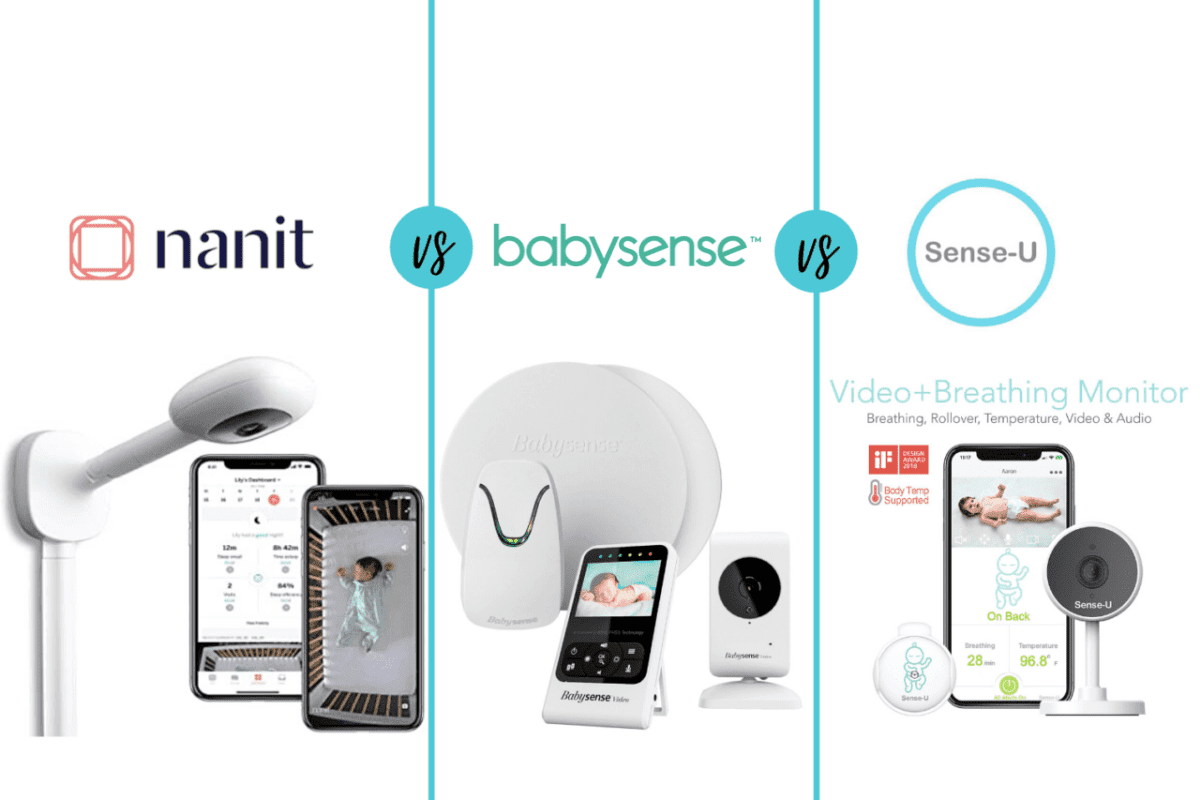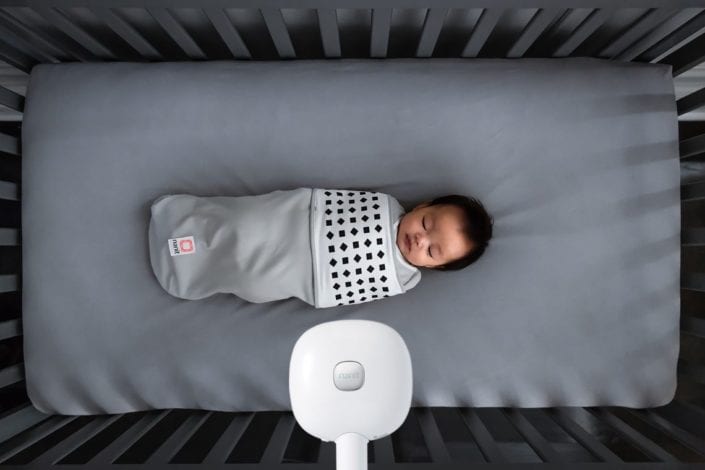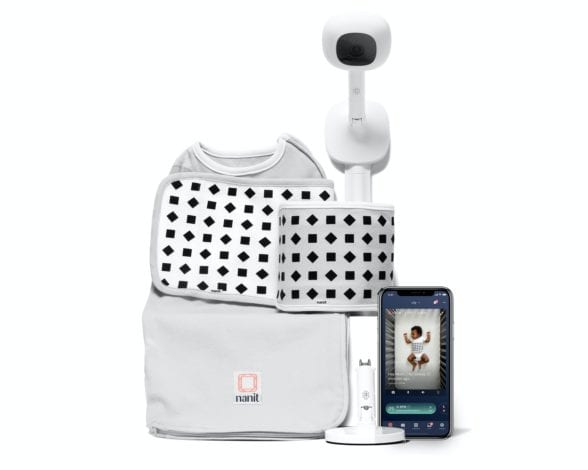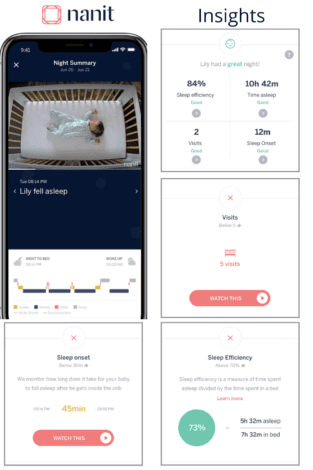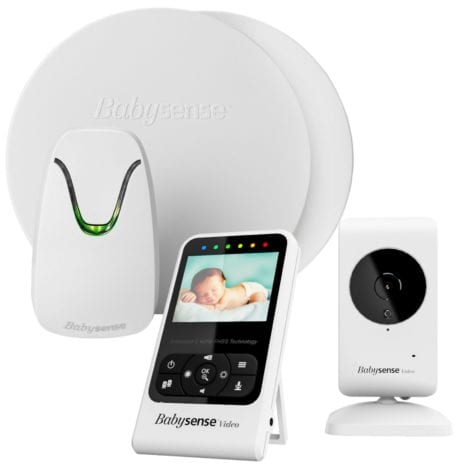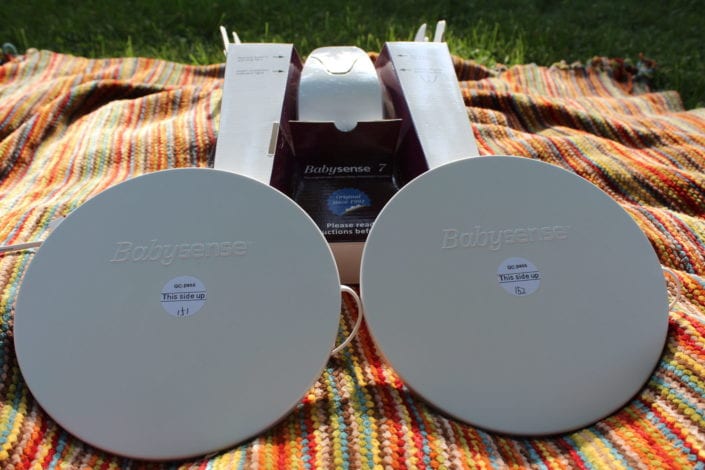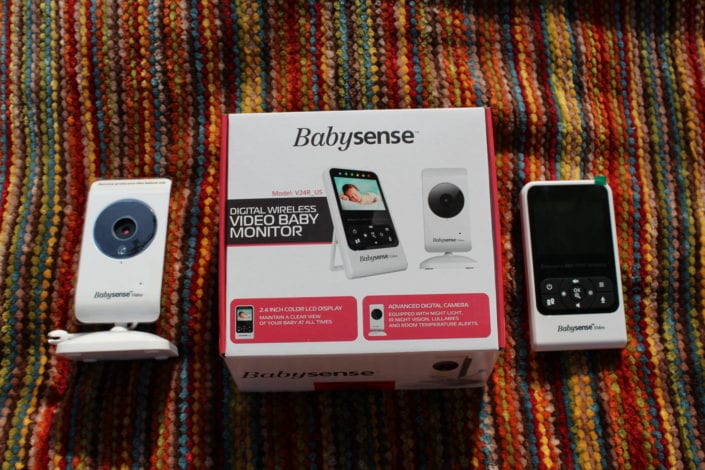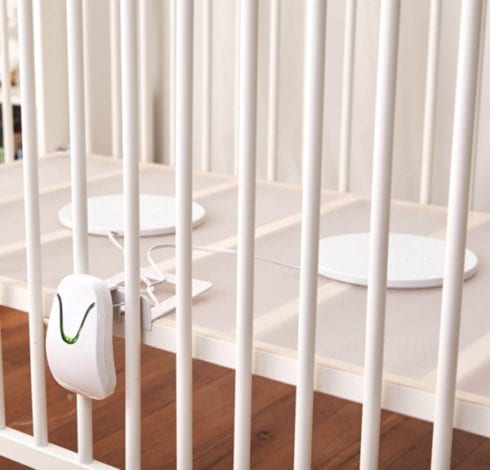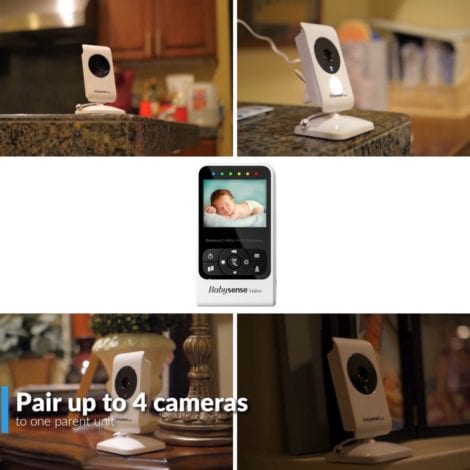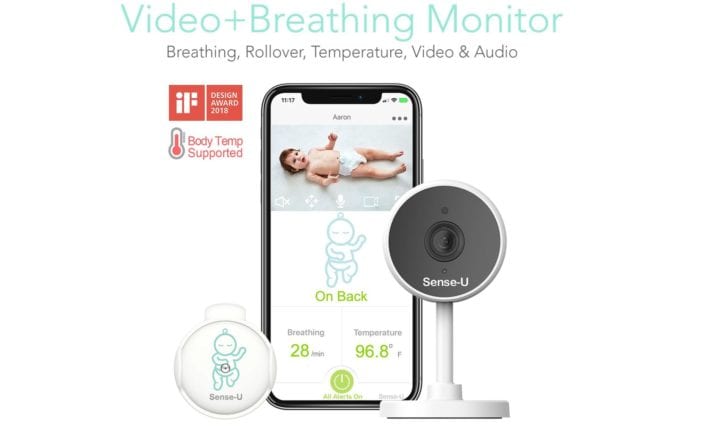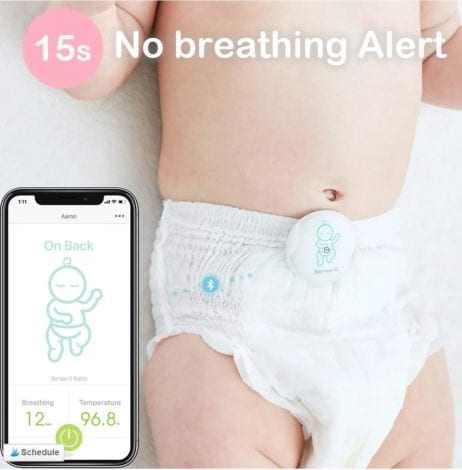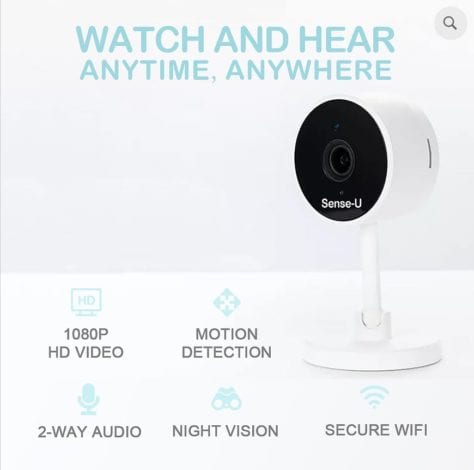Best Baby Breathing Monitors Compared: Nanit vs Babysense vs Sense-U
As a new parent, there isn’t much that’s more stressful than worrying about your newborn baby while she sleeps.
Between the hospital and the media, the stories of SIDS cases are enough to strike fear into the heart of even the most laid-back of parents.
If your child has been in the NICU or was premature, then the worry can be even more prevalent.
A brand new baby is fragile and it’s hard to relax about their well-being. When we’re asleep ourselves we can’t monitor their breathing, if it’s slowing or if they are having any problems.
Standard baby monitors transmit sound and sometimes video to you, so that you can be in another room while baby sleeps. But beyond the wakings and crying, you don’t get much additional information.
Baby breathing monitors on the other hand track baby’s breathing rate and sound an alarm if it gets too slow or if it stops.
Some also track metrics like movement, heart rate, ambient or skin temperature. For many families, these new monitors – with their more advanced metrics – offer them a better peace of mind.
The best baby breathing and movement monitors on the market include:
- Nanit Plus Camera + Breathing Wear
- Babysense Bundle: Video and Movement Monitors
- Sense-U Bundle: Video and Breathing Monitors
Each have bundles offering audio and video monitoring that work together with separate breathing monitors.
We’ve done an in-depth comparison of all three packages so that you can decide which one is the best for your family.
In this review I will discuss:
- Do You Need a Baby Breathing Monitor?
- Comparison Table: Nanit vs Babysense vs Sense-U
- Full Nanit Review
- Full Babysense Review
- Full Sense-U Review
- Which Baby Sleep System Would I Recommend?
- FAQs About Breathing Monitors
Do You Need a Baby Breathing Monitor?
The decision to get a baby breathing monitor depends on how much information you want to have about baby’s vitals.
You may be happy with the standard audio monitor that alerts you when baby is awake and crying. A video monitor will let you see baby as well as hear her. This can help you to check for example that no loose coverings have fallen on her face.
Baby breathing monitors on the other hand, offer you more detailed insights about your baby’s well-being. They track things like breathing rate, baby’s movement and temperature.
New monitors like the Nanit and Sense-U offer advanced insights like baby’s sleeping position throughout the night, how baby’s sleep was overall and baby’s body temperature to name a few.
These monitors can now provide you with a summary of how baby’s night went, without you having to be awake all night alongside them.
Many parents make the decision to buy a baby breathing monitor because they are:
- Concerned about SIDS. SIDS is the sudden death of a child when his breathing stops during sleep. Although they can’t prevent SIDS, baby breathing monitors sound an alarm to alert you that you should check on your baby if their breathing has slowed or stopped.
- Seeking hospital-level monitoring. After being in the NICU with your baby, you may have concerns about coming home. You won’t have all the breathing and heart monitors you’re used to seeing around your baby, to check that she’s well. A baby breathing monitor can offer you a lot of peace of mind as you make the transition to bring baby home.
- Wanting detailed sleep data each night. Some breathing monitors like the Nanit Plus and the Sense-U breathing monitor, translate their data into sleep analysis and advice. This means that you can get a report about your baby’s night without having a night nurse there with them all evening. It’s also helpful for parents who are beginning to sleep train baby to have this information there.
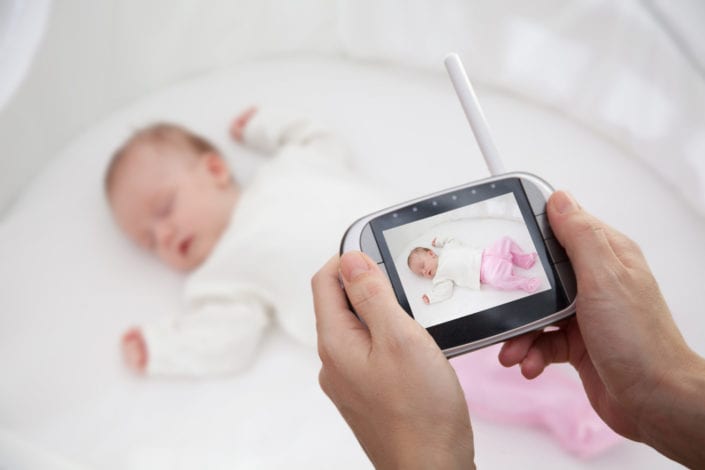
Nanit vs Babysense vs Sense-U
Nanit, Babysense and Sense-U are some of the most reliable and advanced baby monitors on the market.
Their combined sleep systems (offering both video and breathing monitors) all scored 4.2 stars or higher across hundreds of buyers.
They each work in a different way to provide video, audio, breathing and movement monitoring:
- Nanit is either a freestanding or wall-mounted camera monitor. This camera gathers most of the data on your baby including movement and sleep patterns. Baby’s breathing is monitored by separate breathing bands which are wrapped around baby’s chest. All the information about baby goes to their mobile app on your smartphone.
- Babysense offers an under-the-mattress breathing monitor with a separate audio and video monitor which has its own receiver.
- Sense-U has a small round breathing and movement monitor that clips onto baby’s clothes moves as baby moves. It also has a separate camera which gives you video and audio. Both send the data about baby to their app on your smartphone.
 |
 |
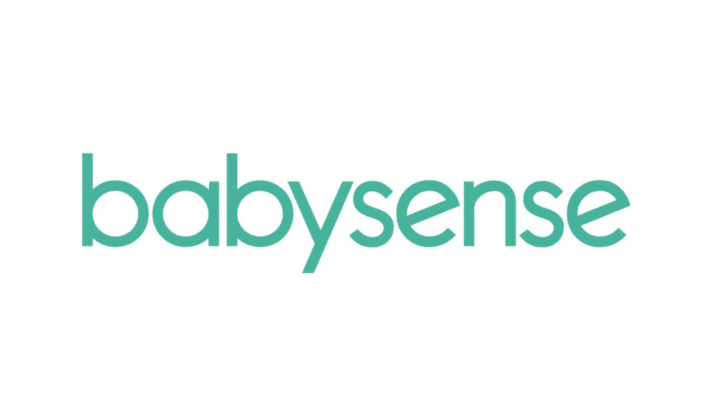 |
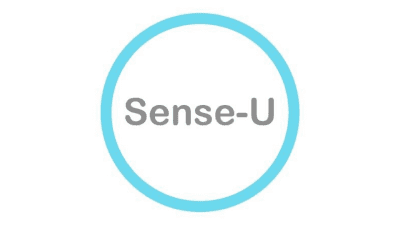 |
| What’s Included | Nanit Pro Camera (freestanding or wall-mounted)1 small breathing band |
Breathing sensor pads
Audio and video monitor |
Clip-on wearable breathing monitor
Wall-mounted video and audio unit |
| Installation | Wall-mounted version: 3 screws and a back-plate
Smartphone app works as receiver |
Sensor pads placed under baby’s mattress
Cable hook for securing loose cables Video monitor is placed on surface |
Clip-on breathing monitor attaches to diaper or onesie
Video unit mounts to wall with sticky pads Smartphone app works as receiver |
| Ease of Setup | 5 minutes or less
Wall-mounted requires drilling |
About 10 minutes
Installing the sensor pads can take a little time |
5 minutes
Clip on the monitor and mount camera |
| Price* | NanitPro Camera: From $299
NanitPro Complete Monitoring System: $379 $24.99 for Breathing Wear starter pack (swaddle and breathing band). |
Bundle: Babysense video and breathing monitors: $159.99
Breathing monitor: $127.50 Video monitor: $59.99 |
Sense-U video and breathing monitors: $299.99 bundle
Video monitor: $129.99 Breathing monitor: $199.99 |
| Features |
|
|
|
| Connectivity & Quality |
|
|
|
| Safety (our rating) | 5 stars
Wall-mounted camera cables secured with hard casing. No contact with baby — Safest of the 3 systems. |
4 stars
Movement monitors are corded and need to be secured. Hook provided to tighten cables and place out of baby’s reach. |
5 stars: Breathing monitor
2 stars: Video monitor Breathing monitor is a clip-on disc. It has a low-EMF design and is cable-free. Video monitor has loose cable — You need to secure it manually. |
| Reviews | 4.6 stars across 968 reviews on 3 websites | 4.2 stars across 162 reviews on 2 websites | 4.2 stars across 782 reviews on 2 websites |
| Special Offers | 10% off bundles: Nanit | Latest discounts: Babysense | 10% off: Sense-U |
10% off bundles: Nanit
Nanit Baby Monitor Review
How it Works
The Nanit Plus camera is the newest monitor on the market and so unsurprisingly has the most advanced features.
The unit itself looks like a friendly robot that mounts on the wall to watch your baby sleep.
As it monitors baby from directly above the crib, it has a complete and unobstructed bird’s-eye view. There’s also no more balancing of the unit on books or nightstands to get the best angle.
The camera cables are secured behind a hard cover that they provide, to keep them out of baby’s reach.
The receiver is your smartphone which connects to the camera through their app. So there isn’t even a handheld unit to worry about losing. The app itself provides a number of unique features and insights about your baby’s sleep.
The breathing band is a soft wrap that you put around baby’s chest and fasten securely. This enables you to monitor baby’s breathing patterns as well. They come in small and large sizes.
There is also a soft night light on the top of the camera, two-way audio so that you can speak to baby and a white sound function that you can control through the app.
10% off bundles: Nanit
What’s Included in the Nanit Complete Monitoring System
Nanit offers a range of bundles to suit your needs.
The most basic option is the Nanit Pro camera, which comes with:
- Nanit Pro Camera – wall-mounted or with a floorstand (floorstand option costs more).
- Breathing band (small).
They also have a Complete Monitoring System bundle which includes the following items:
- Nanit Pro Camera – wall-mounted or with a floorstand (floorstand option costs more)
- Breathing Band (small)
- Smart Sheets to monitor your baby’s height and track growth
- Multi-stand for when you have to take the Nanit with you on the go
They also have all kinds of mix-and-match purchase options depending on your needs when you click on their “bundles” section.
Ease of Installation
The Nanit Plus camera comes as a wall-mounted camera. You can purchase the floorstand separately if you wish to although this is at an additional cost.
Unpacking and setting up the wall-mounted camera is short and sweet. You drill 3 holes into the wall and secure a backplate to it with screws. The camera then clicks into the backplate to complete installation.
Download the app on your phone which acts as the receiver for the monitor.
What Makes Nanit Plus so Special?
Nanit Insights
Nanit is exceptional at knowing when your baby is falling asleep, fidgeting, or waking. It knows if baby had a good night or a bad night and sometimes even what to do about it.
If Nanit thinks you’re having a hard night, you’ll receive helpful tips called Insights. The more you use the Nanit, the more Insights you’ll receive.
Every Insight reflects your own child’s sleep data: there’s no stock advice here it’s all personalised. And they’re all built on science-based recommendations.
The Nanit breathing bands monitor breathing movement to give you peace of mind that baby is breathing at a normal rate. They also use the breathing to pinpoint the quality of your baby’s sleep. The Nanit is very effective at doing this thanks to machine learning.
When your child’s breathing patterns change, Nanit links them to particular sleep stages so that you know your child is getting enough sleep.
You get one year of Nanit Insights for free, and beyond that, it’s $100 per year. (Most parents wouldn’t use breathing monitors for over a year).
Some of the things you will get with Nanit Insights are:
- summary of your child’s sleeping patterns
- video clips from their wakings
- full report of their night complete with a “sad baby” or “happy baby” icon to sum up the evening
- personalised sleep training tips
- breathing monitoring (with the breathing band) and alerts if baby’s breathing is slowed or stopped
- white noise which can be activated through the app to soothe baby back to sleep
- two-way audio so that you can talk to your baby when they get older
- ambient temperature sensors
Nanit Monitors Work Even When Internet Goes Down
We love that the Nanit doesn’t rely on Wi-Fi for transmitting data first. The Nanit sends data to your router rather than the cloud first.
There are two benefits to this approach:
- First, if you lose your internet connection but the router stays up, then you can still use the Nanit to monitor your child.
- Second, the router provides a layer of protection between your child and hackers who could gain access to his video stream if the connection were Wi-Fi-only.
As far as we can tell, this is the only video monitor on the market that works this way, and it’s a massive upside for families with spotty or heavily-used connections.
Safety & Security Features
The Nanit provides its movement, video and sound monitoring through the overhead camera.
This means that there are no cords or bulky items in the crib itself. A single camera provides an bird’s-eye view of your child’s sleeping space, then uses machine learning and sophisticated algorithms to deduce what’s happening.
Parents report shockingly accurate data from the Nanit, all without anything attached to baby’s cot.
The breathing monitor is a soft breathing band that wraps around baby’s chest and is secured together. It provides you with breathing metrics for baby too.
Nanit also gets points for security since it offers 256-bit data encryption and HIPAA compliance. That means federally-mandated security measures protect your child’s data.
Picture and Audio Quality
Unlike many baby monitors, we were impressed by the image quality and 1280 x 980 pixel resolution. The video quality is beautiful, especially with ten infrared LED lights illuminating the shot without disturbing the baby’s sleep.
The camera itself is a wide-angle camera designed explicitly for crib-viewing with no blind spots.
This also makes the Nanit’s nightly video highlights even more enjoyable to watch. (Every morning, Nanit sends a summary of your baby’s night that includes videos and images of your child’s notable moments).
The audio has been greatly improved between the two models: Nanit and the Nanit Plus and is now excellent too.
10% off bundles: Nanit
Nanit Pros and Cons
| Pros | Cons |
| Clear video and audio | Breathing monitor needs body bands to work |
| Two-way talk | Additional subscription for Nanit Insights |
| Breathing monitor (with bands) | |
| Convenient app | |
| Nanit insights: sleep analysis and feedback | |
| White noise | |
| Wall mount or floor stand | |
| Secured, encrypted information |
What Did Other Users Say About Nanit?
The majority of users raved about the camera and the Nanit Insights. They loved:
Nanit Insights
They loved the nightly metrics which were tracked and stored for them each night. Some reviewers said it felt like they had a night nurse with them, keeping an eye on baby.
Personalised sleep suggestions
The sleep suggestions offered by Nanit were very helpful. The app proposes personalised ways you could improve baby’s sleep like getting them to bed earlier.
Unobstructed view of the crib
Many reviewers loved that the camera offers a full view of baby’s crib without anything in the way. It also meant them didn’t have to balance freestanding cameras on objects near the crib to get a good angle.
Secure casing provided for the cords
The cords were covered with a secure casing so that baby couldn’t reach them.
High resolution video
Picture and audio quality were reported as being excellent.
The few drawbacks or improvements that reviewers reported on were that:
- the floorstand is sold separately and so is an extra cost.
- it is still Wi-Fi enabled which means it backs up your images and videos to the Cloud for 30 days (premium Insights users get unlimited backups). Nanit take precautions to ensure that they’re not putting your child’s data at risk.
- the White Noise function has been reported to be a little glitchy to control from the app.
Nanit Review Summary
| Ease of use + installation: | 4 stars | You don’t need to be a handyman, a tech expert, or a superstar mom to get the Nanit up and running. |
| Connectivity: | 5 stars | Most baby monitors have a cloud video feed that transmits right to Wi-Fi. Nanit instead sends video and audio to your home’s router and encrypts it. |
| Image quality: | 5 stars | The Nanit has the best video quality of any monitor we’ve seen, making it easier to use and see baby on. It also makes for cute screencaps of your baby’s sleep. |
| Usefulness of data provided: | 4 stars | Advanced insights provide detailed summaries of your baby’s sleep duration and quality throughout the night. Heat maps provide a record of baby’s movements as well. |
| Data insights provided: | 5 stars | Nanit’s machine learning is the best we came across; you won’t find a baby monitor this smart anywhere else. |
| Market opinion: | 4.6 stars | Nanit scored 4.6 stars on average across 968 reviews on 3 websites. |
Nanit Special Discounts
Save 10% when you build your own bundle: Nanit Bundle
You can now get these items for free with a Nanit Plus Camera:
- 1 year of Nanit Insights (worth $100)
- 1 small swaddle
- 1 small breathing band
Babysense Monitor Review
How it Works
The Babysense is the more economical of the 3 monitors reviewed here. It has a freestanding camera and separate receiver.
It also offers breathing and micro-movement monitoring with its sensor pads which are placed under baby’s mattress.
Babysense Breathing and Movement Monitor
The Babysense breathing monitor has two sensor pads that you place under baby’s mattress. They connect to a unit on the side of the crib.
The sensor discs are sensitive enough to pick up on tiny movements that your baby makes when she breathes.
If the monitor detects that your baby has stopped making these micro-movements (or breaths) for 20 seconds and the unit on the side of the crib sounds an alarm. It also sounds an alert if your baby’s breathing slows to a rate of less than 10 per minute.
Although they offer you 2 sensor discs with the breathing monitor, you only need 1 under the mattress when baby is small and not moving much.
As baby grows and starts to roll around in their sleep you can add the second sensor. This means that baby’s breathing can still be detected if they roll around the crib (up to a certain age when they start to move too much).
Babysense Video and Audio Monitor
Babysense offers video and audio monitoring through a traditional camera and receiver system.
The Babysense camera is a freestanding one which you position somewhere near baby’s crib, where you can get a good view of baby.
You have a separate receiver which shows you video and audio of baby.
This camera also uses infra-red night vision so you can see baby without disturbing their sleep.
The receiver has a number of features to make it convenient for parents. This includes two-way monitor audio and lullabies so that you can talk to baby through the monitor and soothe them back to sleep when they get old enough to understand.
What’s Included in the Babysense Bundle Pack?
You can buy each monitor separately or together with the Babysense bundle pack which includes:
- Breathing monitor: 2 sensitive under-the-mattress sensor pads.
- Video monitor: audio and video monitor with a camera and receiver.
You can also buy these monitors separately if you prefer — see our complete Babysense review here for more details.
Ease of Use and Installation
Installing the Breathing Monitor
The 2 under-the-mattress monitors look like large round discs that you place under baby’s mattress.
They connect to a small device which is attached to the side of the crib. You click this device to start and stop the breathing monitor. It sounds the alarm if baby’s breathing slows of stops.
As the discs are connected to the device on the side of the crib with cords, Babysense provides a hook so that you can secure the cords, making it safer for baby.
Installing the Video Monitor
The camera is plugged in separately and placed near the crib. It has to be placed in a position from which you can see baby well, and where the cords are well out of baby’s reach.
Time to set up both monitors:
It takes a few minutes longer to set up the movement sensors under the mattress. And a few minutes to position the camera unit so that you can see baby.
Still you should be ready to go with the Babysense system in 10 minutes or less.
Once the sensors are in place under the crib mattress, there’s no need to adjust them or move them between uses.
What Makes Babysense Monitors Special?
Babysense Breathing and Movement Monitor
The sensor discs pick up baby’s micro-movements to get an accurate breathing rate for baby.
They can stay in one position once installed and don’t need to be moved around.
The alarm for baby’s breathing can be turned on and off easily by clicking a button on the side of the crib.
Babysense Video and Audio Monitor
The handheld receiver offers a good quality video and audio monitor of baby. It also has a number of other features such as:
- two-way communication ability (so you can hush baby back to sleep)
- lullaby playing which you can do through the receiver unit.
- tilting of the camera to adjust your view which can be done from the receiver (the view can be moved slightly left, right, up or down).
- ‘Cry Alert’ so that your own sleep is only disturbed when baby is crying and not when baby is shuffling around.
- ambient temperature monitor and an alert if the room gets too warm.
- light projection of stars that you can project up onto the nursery ceiling or wall.
Safety and Security
The breathing monitor operates through sensor discs that attach to a small device clipped onto the crib using cords.
These need to be secured. Babysense provides a hook to help with this.
The video and audio monitor don’t operate through WiFi. Instead:
Babysense Baby Video Monitor features 2.4GHz FHSS (Frequency-Hopping Spread Spectrum) secure wireless transmission technology. The monitor provides safe and secure Point to Point digital encryption wireless transmission. The unit operates in 2400-2480 MHz auto tuned frequency, reducing the risk of interference with any other electronic device working in its vicinity.
Babysense Pros and Cons
| Pros | Cons |
| Video and audio monitor | Sleep data not included |
| 2-way talk | No app — video on separate monitor |
| No-contact breathing monitor | Not very portable |
| Ultra-long range (960 ft open space) | |
| Lullaby and white noise | |
| Cry alert | |
| Breathing alert |
What Did Other Users Say About Babysense?
Accurate Breathing Monitor
Overall, parents who bought the Babysense breathing monitor found that the sensor discs were accurate and worked well. It accurately monitored baby’s breathing throughout the night.
The fact that 2 sensor discs were provided, meant that the monitor could still pick up breathing when baby got older and was moving around a bit too.
After 6 months of age though, some babies moved around too much for the monitor to handle. As they weren’t always lying completely on top of one of the two sensor discs, there were times when the monitor couldn’t pick up the breathing movements. (Few parents use breathing monitors after 6 months of age so this may not be a problem).
Good quality video and audio monitor
Users liked the freestanding video and audio monitor and found it a convenient solution for a night monitor.
Two-way audio and lullabies were convenient
A few users reported that they could lull their baby back to sleep without disturbing them or overstimulating them thanks to the two-way audio and lullaby feature.
The main drawback reported with the Babysense was to do with the connectivity. A number of users had trouble connecting the receiver to the video unit through concrete walls or heavy furniture like refrigerators. This could be a problem if you live in a large house across several floors.
Otherwise the reviews were overwhelmingly positive.
Babysense Monitor Review Summary
| Ease of use: | 5 stars | Users report a fast setup process with only three components, and no complaints about the handheld unit which is simple to use. |
| Connectivity: | 3 stars | Connectivity is good. Some users reported trouble staying connected to the Babysense if they lived in a large house, or if there were several walls or heavy furniture in the way. |
| Picture and Sound Quality: | 4 stars | The video quality in particular has improved a lot in the latest model and both are very good. |
| Usefulness of data provided: | 4 stars | The monitor tracks micro-movements to provide feedback on your baby’s breathing. It sounds an alarm if breathing slows greatly or if it stops for 20 seconds. |
| Data insights provided: | 2.5 stars | Babysense gives you immediate feedback on whether your baby is breathing normally based on micro-movement data, but it doesn’t give you reports on that data or analysis. |
| Market opinion: | 4.2 stars | The Babysense breathing and video monitor bundle scored 4.2 stars across 162 reviews on 2 websites. |
Check latest prices and offers for Babysense monitors:
Babysense Bundle: Video & Breathing Monitors together
Separate Babysense monitors:
- Babysense Breathing Monitor
- Babysense Video Monitor
Sense-U Baby Monitor Review
How it Works
The Sense-U bundle comes in 2 parts:
- Sense-U Breathing Monitor: a round device that clips onto baby’s diapers or onesie.
- Sense-U Video and Audio Monitor: sticks onto the wall with a sticky backing.
You can buy these separately or together.
Ease of Use and Installation
10% off: Sense-U
Breathing and Movement Monitor
This Sense-U breathing monitor is a round and discrete clip-on device that you can attach to baby’s diaper or clothes.
Installation is simple, you download the app, pair the device with your phone using Bluetooth, then clip the wearable device to your child’s onesie or diaper. Turn on the app and you’ll see a live continuous feed of your baby’s sleep activity and stats.
It connects to the Sense-U app on your phone. It tracks baby’s breathing, sleeping position throughout the night, baby’s temperature, and more. It offers you a summary of baby’s night through their app.
If your baby’s sleep becomes unsafe, you’re alerted to it. The Sense-U alarms if your baby moves onto his stomach or if her temperature becomes too hot or cold. The same is true if your baby starts breathing too slowly or no breathing is detected.
Video and Audio Monitor
The Sense-U video monitor is a separate monitor and quite a new addition to the Sense-U product range. It offers excellent picture quality.
Installation is easy as it attaches to the wall above the crib using sticky pads. Therefore it can offer a bird’s-eye view of baby’s crib without any obstructions.
However it does have a loose cable which needs to be secured and positioned out of baby’s reach to be safe. This could take a few more minutes to do.
Your smartphone acts as the receiver and you can monitor baby directly from their app on your smartphone.
What Makes Sense-U Monitors Special?
Sense-U Breathing Monitor
The Sense-U breathing monitor is very different from most breathing monitors on the market because it’s a cord-free clip-on device. It tracks a number of different metrics which it saves and transmits to the mobile app on your smartphone.
It moves with baby
Because it clips onto baby’s clothes it can do this even if baby is asleep on their side or tummy. This makes is useful for newborns as well as for older babies.
Tracks baby’s vitals and movements
The Sense-U monitors the following throughout the night:
- Baby’s sleep positions
- Baby’s temperature
- Baby’s breathing rate
It uses Bluetooth low energy technology
It does this using Bluetooth low energy technology (considered to be “almost zero radiation level”) so that it’s safer for baby.
Insights are sent to your smartphone
You get all the insights on your smartphone through their app along with a little diagram of how your baby’s sleeping.
Sense-U Video Monitor
The camera offers high resolution video and audio monitoring straight to your phone with 1080p HD video. It connects through Wi-Fi so that you can monitor baby from another room.
Two-way audio
The Sense-U app allows you to comfort your baby via a two-way audio, which is handy for babies who want to hear their mama or papa’s voice without being too disturbed.
Safety and Security
The clip-on breathing monitor uses low radiation Bluetooth technology, making it one of the safer monitors in that respect. It also has no cables or cords, it just clips on. So all in all it’s one of the safest devices on the market.
The video monitor uses secure WiFi. However has a loose cable which connects the wall-mounted camera to the plug. This means it could be left hanging down the wall behind baby’s crib which isn’t safe. The cable should be tightened, secured and placed well out of reach of baby.
Sense-U Pros and Cons
| Pros | Cons |
| 1080p HD video | Clip-on sensor can be bulky |
| 2-way audio | Not zero-radiation |
| Small sensor clips on diaper | |
| Detects sleep position and motion | |
| Monitors breathing and body temperature | |
| Alerts when in dangerous position | |
| Alerts during weak breathing | |
| No cord sensor | |
| Convenient app |
What Did Other Users Say About Sense-U?
While the Sense-U breathing monitor has a large number of positive reviews, the Sense-U video monitor is quite new. So there are limited reviews available online. We found 10 ratings with an average of 4.5 stars. Most users were impressed with the:
- image quality
- ease of installation.
Sense-U Breathing Monitor
The Sense-U breathing monitor had excellent reviews online. The clip-on monitors were purchased mainly for peace of mind but reviewers loved how:
- the breathing monitor worked even when baby rolled around (it follows where baby goes)
- it monitored breathing accurately
- it was small and light
- it had extra insights like sleep position and baby’s own temperature
In terms of improvements that could be made, some users didn’t like that you can only pair the Sense-U with one smartphone receiver. This meant they had to pair and unpair the device whenever another carer took over. However this takes only a minute to do as it’s all through Bluetooth.
The Sense-U also has a Bluetooth range of up to 50 feet. If you have a large home or want to use it across many floors, then this device may not connect all the way across it. That being said one reviewer purchased the Sense-U breathing monitor and found that it worked very well in their 4-bedroom new-build from both upstairs and downstairs.
Overall, most parents seem to think that the low radiation, short range, and single-pairing limitations are worth the peace of mind. The Sense-U gets consistently great reviews across major retailers.
How I found the Sense-U breathing monitor?
We live in a two-bedroom, single-level home, so the short Bluetooth range wasn’t an issue. There’s only 50 feet of space between the front door and my son’s bedroom, so I had plenty of space to move around the house while Nico napped.
Like many babies, my son doesn’t love staying still while I’m attaching a device to his clothes. The Sense-U is incredibly easy to attach without fidgeting or fussing, and it stays on even when he moves around during sleep.
Overall, the Sense-U was the right choice for my family. But other families may prefer the advanced insights of the Nanit Plus or the separate video receiver of the Babysense.
Sense-U Monitor Review Summary
| Ease of use: | 5 stars | The Sense-U breathing monitor has the quickest setup process out of the three monitors reviewed. You can be ready to go in less than 5 minutes. |
| Connectivity: | 3.5 stars | Connectivity was good but it does have a range limit of 50 feet (15 metres). However some reviewers stated that they had connectivity across large homes without any issues. |
| Picture and Sound Quality: | 4 stars | Video image is very clear. |
| Usefulness of data provided: | 4 stars | The Sense-U breathing monitor collects multiple statistics about your baby’s well-being included core information such as their temperature and breathing rate. |
| Data insights provided: | 4 stars | The app shows you baby’s sleep position throughout the night and baby’s breathing rate with an alarm if no breathing is detected. It also checks baby’s body temperature and that it’s not too high or low, as well as ambient temperature. It alerts you if baby moves onto their stomach too. |
| Market opinion: | 4.2 stars | The Sense-U baby breathing monitor scored 4.2 stars across 782 reviews on 2 websites. The video monitor had only 10 reviews so far but these were at 4.5 stars. |
Check latest prices and offers for Sense-U monitors:
Sense-U Bundle: Video & Breathing Monitors together
Separate Babysense monitors:
- Sense-U Breathing Monitor
- Sense-U Video Monitor
Which baby breathing monitor is best?
Each of these baby sleep systems offer useful insights into baby’s well-being. They do this in a very different way so it’s hard to choose just 1.
The Nanit has gorgeous picture quality and great tech behind it. Their Insights, and personalised recommendations for your baby have been compared to someone being physically with your baby through the night.
Their camera offers an overhead view without obstructions and they have kept safety in mind by providing secure casing for the cables. Their breathing straps mean you can keep an eye on baby’s breathing too. However all this tech does mean it comes with a higher price tag than the other monitors.
The Babysense on the other hand has an under-mattress breathing monitor. This tracks baby’s micro-movements and breathing really well.
The video and audio monitor is similar to a lot of classic monitors on the market but the newest model offers great picture and sound quality as well as some other useful features.
While some users have had issues with the range of reception, it’s uncertain what obstacles were in the way. It has good reviews across a range of websites and the price is more economical.
The Sense-U has a unique wearable breathing monitor that just clips onto baby’s clothes and offers insights through the app. It can track baby’s movements, breathing and even temperature, no matter what their position. As it clips onto baby’s diaper it can go where baby goes.
The Sense-U camera has great picture quality and can also be used from their smartphone app. However as it’s new there weren’t enough reviews available online for us to provide a complete overview of users’ experience. We also had concerns about the loose cable coming out of the camera that does need to be secured and kept out of reach of baby for safety reasons.
Each of these monitors has its own features and benefits, but for my family, I found that the Sense-U breathing monitor was the right choice. Even without the video and audio monitoring. It was easy to set up, had a good range and kept providing me with insights even when my son moved around.
However if you prefer to have video, audio, breathing and movements all within 1 device which also provides advanced insights, then you may prefer to go with the Nanit. Or if you feel more comfortable with a great quality traditional monitor, which has a separate receiver (as opposed to an app) then the BabySense would be right for you.
Whichever monitor you choose, we hope that they provide you with peace of mind while baby sleeps.
Special Offers on Best Baby Breathing Monitors:
10% Off Bundles: Nanit Breathing and Video Monitors
Check Latest Offers (up to 20% off): Babysense Breathing and Video Monitors
10% Off: Sense-U Breathing and Video Monitors
Alternatives to Nanit, Babysense, and Sense-U
If you’re looking for other options for baby breathing monitors, here are some of our other top recommendations:
Owlet is similar to Sense-U, but utilizes a sock as a sensor as opposed to clip-on device. This might be better for those that don’t like anything around their baby’s waist. (see our Nanit vs. Owlet review here).
Miku is another breathing and video monitor that requires no contact with baby at all. We love that it’s one of the most minimalist set ups (see our Nanit vs. Miku review here).
Frequently Asked Questions: Breathing Monitors
How do baby breathing monitors work?
Baby breathing monitors detect micro-movements in your baby while they’re sleeping. These are used to detect baby’s breathing rate.
The three baby breathing monitors reviewed here all do this in different ways:
- The Nanit has a soft band that wraps around baby’s chest – either over or under their arms. This means it can detect the rise and fall of baby’s chest.
- The Babysense uses round sensor pads that you place under baby’s mattress. These are so sensitive that they can detect the micro-movements of baby’s breathing through the mattress.
- The Sense-U has a small round clip-on device that attaches to baby’s diaper or clothing and monitors a number of different metrics including breathing.
Adults usually breathe at a constant rate, but young babies often have periods of shallow breathing.
These breathing patterns are normal, but they can become dangerous when they lead to extended periods of apnea or stopped breathing.
Most monitors alert you when the data indicates that your baby hasn’t moved in 15 or 20 seconds.
Some monitors include other data, like room temperature or humidity to warn you when the environment isn’t ideal for sleep safety.
Do baby breathing monitors prevent SIDS?
The current research indicates that home breathing monitors don’t prevent SIDS.
They can alert you to an apnea episode where your baby temporarily stops breathing. Still, the American Academy of Pediatrics says that these episodes are normal in the first months of life and may not be linked to SIDS. It’s especially common to witness apnea episodes if your baby is a preemie.
You shouldn’t rely on baby breathing monitors to prevent SIDS alone. Instead, use safe sleep recommendations including:
- Putting your baby to sleep on her back
- Using a firm crib mattress which is new
- Avoiding loose bedding or toys in the crib
- Not bedsharing
- Keeping your child in your bedroom for the first six months of life
Do parents find that baby breathing monitors are worth it?
Even though the research says these monitors don’t protect babies against SIDS, they can still provide peace of mind in some circumstances.
There’s no shortage of reviewers who believe that a baby monitor saved their child’s life:
- An Amazon reviewer who bought Babysense reported that the product alerted him to a 20-second apnea episode in his daughter, and he feels that the device could have saved her life.
- Another Amazon shopper reported that Babysense alerted her to an apnea episode caused by her child’s sleep sack being wrapped around her face.
Are baby breathing monitors safe?
While it’s impossible to say that all baby breathing monitors are safe, the newer models are certainly taking on board safety concerns into their designs.
The main safety checks to do with any baby monitor are:
- Loose cables. Choose monitors with cordless operation or minimal cables to lessen strangulation hazards (Nanit uses a cord management system that stows extra wires under a hard cover where your baby can’t find them.) Always make sure that any cables are secured tightly and placed well out of reach of baby.
- Secure mounting. Use a tip-proof stand or secure wall-mounting to ensure the monitor never comes into contact with your baby
- Hacker safety. There have been some stories of hackers accessing the monitors and even tapping into the audio to shout through them. Check that your monitor is using high level encryption, change the password to a strong password of your own (ideally without names or dates) and keep the devices up to date or enable automatic updates.
Out of the 3 devices monitored here, Nanit has scored the highest on our safety rating due to its secure wall-mounting (or stable free stand) and hard cable covers.
How long should you use a baby breathing monitor?
Talk to your doctor about how long to use a baby breathing monitor. There’s no set recommendation that’s right for every baby.
SIDS risk peaks by four months, decreases after six months, and almost disappears by 12 months. If your child doesn’t have other risk factors such as illness, you may feel comfortable to stop monitoring at the six- or 12-month mark.
Always talk to your child’s doctor before stopping your child’s monitor use if there’s a medical condition involved.
Is the Nanit Pro worth it?
The Nanit Pro is worth it if you’re looking for an all-in-one solution to baby monitoring — including breathing, video capture, audio, ambient temperature, and more! Their Nanit Insights subscription can even give you personalized analysis of your baby’s sleep and tips on how to improve issues.
Of the 3 monitors we reviewed, it’s the most comprehensive in terms of the number of features offered.
Are Babysense monitors good?
The Babysense breathing monitor is good if you want sensors that are placed under the crib mattress and don’t require frequent charging (battery life of 6 months).
Where do you put the Sense-U?
The Sense-U breathing and sleep sensor is clipped onto baby’s diaper. While the video camera can either be placed on a surface to stand on its own or mounted to a wall.
Special Offers on Baby Breathing Monitors:
Nanit
Save 10% when you build your own bundle: Nanit Bundle
Babysense
Latest Offers: Babysense Breathing and Video Monitors
Sense-U
10% Off: Sense-U Breathing and Video Monitors

